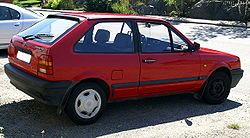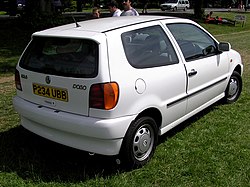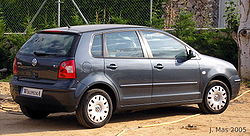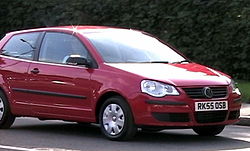Volkswagen Polo
| Volkswagen Polo | |
|---|---|
| Manufacturer: | Volkswagen |
| Production: | 1975–present |
| Audi 50 | |

| |
| Production: | 1974–1978 |
| Class: | FF compact car |
| Body Styles: | 3-door hatchback 2-door sedan |
| Mk I | |

| |
| Production: | 1975–1979 |
| Class: | FF compact car |
| Body Styles: | 3-door hatchback 2-door sedan |
| Mk IF | |

| |
| Production: | 1979–1981 |
| Class: | FF compact car |
| Body Styles: | 3-door hatchback 2-door sedan |
| Mk II | |

| |

| |

| |
| Production: | 1981–1990 |
| Class: | FF compact car |
| Body Styles: | 3-door coupé 3-door hatchback 2-door sedan |
| Mk IIF | |

| |

| |
| Production: | 1990–1994 |
| Class: | FF compact car |
| Body Styles: | 3-door coupé 3-door hatchback 2-door sedan |
| Mk III | |

| |
| Production: | 1994–2000 |
| Class: | FF compact car |
| Body Styles: | 3-door hatchback 5-door hatchback 4-door sedan 5-door estate |
| Mk IIIF | |
| Production: | 2000–2002 |
| Class: | FF compact car |
| Body Styles: | 3-door hatchback 5-door hatchback 4-door sedan 5-door estate |
| Mk IV | |

| |
| Production: | 2002–2005 |
| Class: | FF compact car |
| Body Styles: | 3-door hatchback 5-door hatchback 4-door sedan |
| Mk IVF | |

| |
| Production: | 2005–present |
| Class: | FF compact car |
| Body Styles: | 3-door hatchback 5-door hatchback 4-door sedan |
The Volkswagen Polo is a compact car manufactured by Volkswagen, sold mainly in Europe, but available in a slightly more economic version in most export markets. It is generally available only as a hatchback but there have also been sedan and wagon variants. The current sedan is only available in China, South America and South Africa, where sedans are more popular. The first generation's sedan version was called VW Derby or VW Polo Classic.
Audi 50 (1974-1978)
The Audi 50, a design penned by Giorgetto Giugiaro, was a three-door hatchback launched by Audi in 1974 and sold only on continental Europe. The car was offered with a single capacity engine - 1093cc - producing either 50 or 60 PS (37 or 44 kW/49 or 58 hp) for the LS and GL models, respectively. The model was popular on the continent for both its high specification for a car of that time and the relatively low cost it was sold at. After the introduction of the Mk 1 Polo, the cheaper VW model outsold it, and Audi discontinued the line in 1978, after a total production of 180,000 units. Audi did not produce another car for the supermini class until the Audi A2.
Mk I (1975-1979)
The Mk I Polo, a badge engineered version of the Audi 50, was introduced in 1975. The differences between the Audi and VW models were minor, with the Polo being cheaper and much more basic. It was manufactured at the Volkswagen plant in Wolfsburg. In 1977, the Derby sedan was released, which was simply a Polo, identical to the hatchback from the c-pillar forward, with a large trunk (boot) attached (an old Audi proposal, but never sold by this brand).
When first on sale the range topping car, the LS model, was sold for £2,699 in the UK and featured the 60bhp 1043cc engine found in the Audi 50. Other specifications included parking lights, rear wash wipe, driver sun visor, chromed bumpers and 4.5J X 13" wheels. The N model was the basic starting spec lacking many of the features of the LS. In 1979 the GLS was introduced, replacing the LS as the range-topping car Specification upgrades included chrome headlight and grill surrounds, sunroof, a cigarette lighter and chrome wheel trims.
895 cc, 1093 cc and 1272 cc engines were used, with the 895 cc only used in the Polo htachback, and the 1272 cc only in the Derby, Audi 50, and the rare Polo GT. Different levels of compression were used on each size to achieve different power outputs, and the variations are numerous, often differing depending on the country of sale, ranging from 35 to 60 PS (26 to 44 kW).
Mk IF (1979-1981)
The Mk I Polo and Derby were facelifted in 1979 (Mk IF), where it got plastic bumpers, a different front grille and a revised dashboard. The round headlights of the Derby were replaced with square ones, bringing it in line with the similar Golf-based Jetta sedan.
Further models were added including CLS, S and an out run LX model. The Mk1's production run finally ended in October 1981 after a six year run that resulted in the sale of 86,000 models in the UK alone.
Mk II
A revised model (Mk II) was introduced in October 1981, with the major change being the introduction an additional body style with a steep (almost vertical) rear screen, as well a version with a diagonal rear screen and a similar profile to the previous model. These two body styles were called the Wagon/Hatchback and Coupé respectively, although in fact both were three-door hatchchbacks. The saloon version was no longer called the Derby in all countries, and was changed to the Polo Classic.
At launch the basic C model cost £3,799 with the higher model of the CL and range topping GL all being powered by 1043cc petrol engines. Available with the 1093cc engine the "coupe" featured additions such as sporting seats trim, wheel arch extensions, rear spoiler, low profile tyres and a rev counter.
The GL was also up-speced to a 60bhp engine and this change was reflected in its £4,798 price.
In 1984 an all-new engine was introduced and provided the basic engine for all 1.3 Polo's for the next 10 years. The 1272cc, 55bhp engine was found in the C, CL, GL and Coupe pushing the cost for the later up to £5,070.
In 1985 the first Coupe S was introduced in the UK. Basically a renamed continental Polo GT, the Coupe featuring the same 55bhp engine but also featured twin headlights, a digital clock and sports seats. Priced at £5,654 when new this car remains one of the most popular Mk 2 Polo's seen on the road today.
1093 cc or 1272 cc engines were available at launch. In 1986, the Polo received numerous technical impreovements; amongst many other minor updates, the engines were changed to lower maintenance hydraulic tappets, new camshafts and valve gear and an automatic choke; the 1043 cc engine replaced the 1093 cc, and in some markets the 1.3 L engine was available with fuel injection and equipped with a catalytic converter.
Production was expanded to Spain in the mid 1980s following Volkswagen's takeover of SEAT.
The supercharger-equipped GT G40 version was introduced in 1987, first as a limited batch of about 500 cars (as a homologated version of the G40 Cup) and later as a normal production version. In Germany VW built the LHD only Polo Coupe GT G40. Based on the 1272cc 55bhp engine it featured a small bore G-Lader supercharger. Used to set a number of world endurance speed records - such as the 24 hour 130mph record. A small number of these cars were built for production but were mainly sold to VW workers. This model of Polo was used extensively by Volkswagen to develop future innovations. The G-superchargers were first developed as a G40 to test the concept before the larger and more technically challenging G60.
An extremely fuel efficient 2 cylinder diesel was prototyped in the mid 1980s with a G40 supercharger to overcome its small capacity. Making it into actual production though, in 1983, there was also a variant called the Formal E. The E stood for Economy and utilised an early stop-start ignition system that would cut the engine when idle for more than 2 seconds to save fuel whilst temporarily stopped in traffic. It would be re-activated instantly by moving the gear lever to the left in neutral. There was a toggle switch labelled 'SSA' underneath the light switch to enable the system. The C Formal E used a high compression 1272 cc engine, and longer gear ratios to further save fuel. A similar system was later used on the Mk III VW Golf and are noe used by other car manufacturers.
Other special feature models were introduced over the rest of the period of the Mk2 production run including models such as the Twist, Parade and Country.
Production of the Mk2 finally ceased in September 1990 when the facelifted 2F or Mk3 was introduced.
Mk II Facelift (1990-1994)
A facelift in 1990 (Mk IIF) saw square headlights, bigger bumpers and a new interior (dash and door trim). The three different styles (coupe, hatch and saloon) were maintained. As well as the cosmetic differences, under the skin the car received modifications to the chassis and suspension as well as the addition of servo-assisted brakes. All models were fuel injected and with catalytic converters as standard, both firsts in the supermini class.
In 1990, production expanded to Poland (near Wartburg production facilities), but stopped again in 1992 as Eastern Europe preferred the larger Golf. The Derby was only produced in Spain, and ceased production in 1992. At this point, the Polo was now terminally dated: The follow-up model, the 6N version was already well-developed, but due to the high sales numbers, production of the other Polo models (hatchback and Coupé) was continued to 1994 in Wolfsburg and Spain. Volkswagen used the extra two years to restudy the 6N and change the format slightly before introduction in 1994.
The basic car was the 1043cc Polo Fox featuring a 45bhp engine, this was competitively priced against other cars of its type at £6,500 in the UK with both body styles being priced identically. The range was topped by the hatch back and coupe GT model featuring a 1272cc Digifant multi-point injection engine similar to the 8V Golf GTI engine of the same time. With a quoted top speed of 107mph and external additions such as arch extensions and side skirts, sports seats, 3 spoke steering wheel and black VW emblems this was the sportiest VW Polo to date. The CL was the interim model. With a 1272cc single point injection engine producing 55bhp it filled the middle ground between the Fox and the GT and was the best selling Polo of this period.
Soon after the launch of the Mk2F, the supercharged G40 was made available in full series production version (£11,568 in the UK) in all markets. Similar to the previous model, VW Motorsport modified G40 Cup cars were sold for racing in a one-make series, the Volkswagen Polo G40 Cup. Similar to that found in the Mk2 the engine produced 113bhp (the addition of a catalytic converter lowered the power output from that of the Mk2) and gave 0-60 figures of 8.1 seconds and a top speed of 125mph. Lowered by 25 mm over the standard Polo and featuring special addition Le Mans sports seats, similar exterior styling to the GT with the addition of a bee sting aerial and 5.5J X13" BBS RA cross spoke alloy wheels.
Additional special feature models included the Boulevard and Genesis. The Boulevard was a special equipment Fox featuring such items as a glove box door and CL wheel trims whilst the Genesis could be bought in either 1043 or 1272cc guises. One of the first of the special models VW offered named after bands, the Genesis featured "Modekaro" seats from the Sirocco GT II, a rev counter, sunroof and digital clock. The out run model of the Mk2F was the Match. Featuring five spoke Sport Rader alloy wheels along with £640 worth of other extras it proved relatively popular considering the imminent arrival of the Mk4, a car which took the Polo to different levels of refinement.
Mk III
The Mk III Polo 6N appeared in 1994, and was a completely new model, based on the same platform as the SEAT Ibiza Mk2, launched a year earlier. The Polo was launched as 3-door and 5-door hatchback versions, and was aimed at addressing many of the previous model's shortcomings, principally the lack of a 5-door version, and feeble performance. Although mechaically the model shared many components, including engines, with the Ibiza, and the two cars shared a dashboard, outwardly they were different, with no shared body panels.
A year later, sedan (Polo Classsic) and station wagon (Polo Variant) versions were also added to the range - these were badge-engineered versions of the Ibiza-based SEAT Cordoba Mk1. They were referred to internally by VW as 6K, and shared body panels with the SEAT model rather than the hatchback models. The Mk1 Caddy van shares the same platform and front end styling as these models. A convertible version was not produced, although a version with an electrically sliding full length, called the Polo Open Air, was avaialble.
Initially the car was available with the 1043 45bhp 1272cc 55bhp from the previous generation Polo and a 1598cc engines . A new 1.4 litre engine replaced the 1.3 L in 1996. In 1997 the 1043cc engine was finally retired and replaced by all-new aluminium blocked multi-point injection 999cc developing 50bhp. The Classic and Variant models featured a 75bhp or 100bhp 1.6 litre or a 64bhp 1.9 litre. For the first time, turbodiesel engines (a 1.9 litre engine) was available in a Polo, although only in the 6K models. Due to its smaller engine bay, the standard 3 and 5-door 6Ns never got a turbodiesel engine until the facelift in 2000.
Sporting variants were not introduced initially, and a supercharged G40 version of the Mk III was never made, but a GTI version introduced, in 1995, catered for the hot hatch market. However, with a limited production run of 3000 units the Mk 4 GTI never made it to Britain. Featuring a 1.6 16V 120bhp unit that would later be found (with power hiked to 125bhp) in the later model, the car came with 15" BBS alloys and could sprint to 60 in just 9.1 seconds. This was powered by a 16-valve 1.6 L engine, its output was 125 PS (92 kW/123 kW). Then the 16V was introduced to replace the GLX. One of the most popular Mk4 versions with modifiers the 1.4 16V unit came with 100bhp as standard. However, with a 0-60 in 10.6 seconds and a top speed of 117 mph the car was no match for the similar Ibiza with a 2.0 16V engine. At a cost of £12,095 for the three-door model this car was often seen as over priced for the kicks it delivered.
The new model was better equipped than ever before and a range of models featured items such as colour coded bumpers, heated/electrically -adjustable mirrors, four speaker stereo, dust filters, central locking, read head restraints, split rear seats, fog lights, alloy wheel, air bags and so on. The car was available originally in four trim levels ranging from the L at the bottom level of the scale through the CL and GL to the range topping GLX model. The Polo Harlequin was an unusual edition was the , which features a multi-coloured body with each panel in a different colour ranging from red, yellow to pistachio green and blue. These cars did not prove popular in the UK, but sold more in Contenintal Europe.In 1994 the Polo SE or Special Equipment was launched. Based on the 1.4 L it featured a number of features from higher spec models such as the GLX bumpers, Sport Rader alloy wheels, tinted rear light clusters and clear indicators. The Mk 4 came to the end of its production run in 1999 with another Polo Match. Similar to the Mk 3 version of the Match this out run came with alloy wheels and a number of other extras found on higher spec models.
The VW Lupo and SEAT Arosa were based on a shortened version of the 6N platform, and shared many components.
Mk III Facelift
The Mk IIIF was released in 2000, with the hatchback models featuring updated styling including new headlights and bumpers and an all new interior based on that of the Lupo. Although the car was similar in appearance to the Mk III (the bodyshell was fully galvanised and stiffened but not fully redesigned, although some panels were changed), Volkswagen claimed that 70% of the components were new. Power steering, antilock brakes and twin airbags were made standard. The sedan and estate versions received the new interior, but not the full exterior facelift. Also, the 3-cylinder 1.4 TDI engine was introduced for the 3 and 5-door hatchbacks.
Specification options ranged from power steering, tinted glass, split rear seats, electric windows and cup holders to ABS, air conditioning, Xeon headlights and satellite navigation. Thirty-two models with seven engines ranging from the 1.4 diesel to the 1.6 16V GTI made the choice of Polo the widest ever seen. The base model was the E with the option of no less than 5 engines ranging from the 1.0 50bhp to the 1.9 TDI unit found across the VAG range, producing 90bhp. At a cost of £8290 for the 1.0 hatchback this was considered cheap for the build quality and spec list when compared to other cars. Then came the S and SE models. With engine options ranging from 60bhp to a 110bhp diesel they offered a range of features usually found on the more sporty models but without the insurance or running cost woes.
VW offered two sporting models, the 16V and GTI. The 16V came with a 1.4 16V 100bhp engine and had options such as 15" Spa alloys, air conditioning. However, of more interest was the GTI, the first time the Polo had such high spec on a UK model. Available only in the hatchback form the GTI was powered but a 1.6 16V 125bhp engine making it the most powerful Polo straight out the factory to date. External changes gave the car the looks to match its power. Deeper front bumpers with mesh inserts, side skirts, fog lights, a mesh grill and 15" BBS split rims suited the car well. There was also extras such as air conditioning, Xeon headlights and a CD autochanger, leather and satellite navigation. Available in the same three colours as the original Golf GTI - red, black and silver - the car's production run was short, and its price high, at £13,995.
Mk IV
Launched in September 2001, the all-new 9N (Mk IV) model was put on sale in early 2002. In keeping with VW's aim of floor pan sharing it shares its platform with the Mk 3 SEAT Ibiza and the Skoda Fabia. Launched in September 2001 the car looked more similar to the smaller Lupo than it did to previous Polo models. The major visible change was from rectangular headlights to two round headlights similar to the VW Lupo, however major internal changes have occurred, and it bears more structural resemblance to the 6K than the 6N. At a length of 3.90 m, its was now larger than the first generation of its bigger sibling, the Golf (3.82 m). Due to its size, use of techology originally available from the Golf up and the use of luxury trim levels, the Polo was considered too expensive for its segment for non-European markets.
Starting with a revolutionary 1.2 three cylinder engine developing 55bhp there is then a 1.4 75 or 100bhp engine. However, the 1.9 TDI PD 100bhp unit will be in introduced in the future whilst rumours of a Polo featuring the 1.8 20 Turbo engine abound.
The models range includes the norm for current VW's from the E and SE to the Sport whilst featuring all the extras that you'd expect of a current mid-sized small car. Items such as ABS, power steering, front and side air bags and front and rear head restraints as standard on all models and ESP, brake assistance, air conditioning, satellite navigation etc. as options on higher spec models.
There was also an 4x4-stylised version of the Polo available, named Polo Fun. Although, it was never available with Four-wheel-drive.
A sedan version is available in South America - produced in Brazil - and South Africa, called the Polo Classic. In Australia, where it has been sold since 2004, the sedan is imported from China. This has the distinction of being the first Chinese-built car to be produced in right hand drive.
Mk IV Facelift
In 2005, the 9N (Mk IVF) was facelifted with new Passat-style headlights, taillights and a different hatch. The Mk IVF was designed by Brazilian Walter De Silva.
On October 21, 2005, the new Polo GTI was unveiled at the annual Australian Motor Show. The Polo GTI bears some resemblance to the Golf GTI. It uses the 150 PS (110 kW) version of the 20-valve 1.8 Turbo engine.
The successor of the Polo Fun is now called "CrossPolo".
Trivia
- Some Polo models from the 1970s and 1980s used the emblem of the city of Wolfsburg on the steering wheel hub rather than the normal Volkswagen logo seen today. This was typical of older Volkswagens, such as the Beetle.
Position in the Volkswagen lineup
The Polo is the second smallest model in the current VW range, larger than the VW Fox and smaller than the VW Golf. Curiously, the latest incarnation of the Polo is actually larger than the original Golf. It is mechanically very similar to the SEAT Ibiza and Skoda Fabia, being based on a standard VAG group chassis used for a large number of models. The SEAT Ibiza was sold in South Africa as the Volkswagen Polo Playa.
External links
- Used VW Polo information
- Club Polo UK Website (source for some of the model history information)
